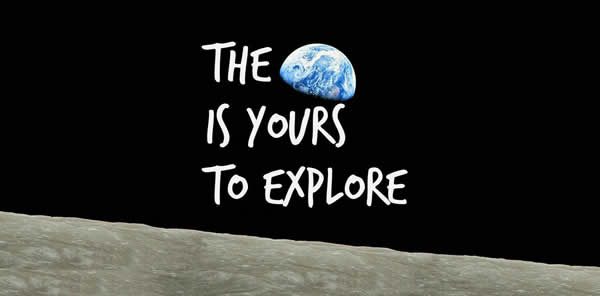HiRISE images
Almost a dune

A Piece of Mars: This field of 2 m wide sand ripples has a dark splotch in the middle (the scene is 300x225 m or 984x738 ft). The splotch is the peak of a low hill that straddles the classification gap between proper dunes and simple drifts of sand. Maybe it was a dune that has been modified down to this bump, or maybe it's a drift that could grow into a dune, if enough sand blew in and accumulated on it. (HiRISE ESP_038117_1385, NASA/JPL/Univ. of Arizona). read more ❯
Lumpy bumpy dunes

A piece of Mars: These funny shaped dunes were formed by winds blowing from two directions - one from the top of the frame and one from the upper right. Both winds make steep slopes (slip faces) on the downwind (lee) sides of the dunes. With enough sand supply, the "point" between the slip faces will continue to extend toward the lower left as the two winds take turns driving the sand back and forth. (HiRISE ESP_037203_2555, NASA/JPL/Univ. of Arizona) read more ❯
Changing winds

A piece of Mars: There are two sets of ripples here: tan ones and gray ones, each oriented to a different wind (scene is 300x225 m, or 984x738 ft). The gray ones sit on top of the tan ones, so the gray ones are younger. Now come the fun questions: why the different colors? Are they made out of different material (and if so, why), or are the older tan ones different because the gray sediment has weathered to tan over time? (HiRISE PSP_002387_1985, NASA/JPL/Univ. of Arizona) read more ❯
Missing bedrock

A piece of Mars: Wind flow on Mars can be quite dramatic. Here, a single wind-sculpted hill stands 1.5 km (0.93 mi) wide and 600 m (1970 ft) high (color shows elevation). That sounds big, but vastly larger is the volume of material that has been removed to form it. A sandy ridge forming a "bow shock" indicates present-day winds still blow in the same direction. (HiRISE ESP_017173_1715, NASA/JPL/Univ. of Arizona) read more ❯
Holes around rocks

A piece of Mars: This scene (509x382 m, or 1670x1253 ft), aside from showing some lovely rippled dunes, has many car-sized boulders in it. Some are surrounded by ditches in the sand, like little moats. Why? The sand is blown away from the ground as wind impacts the rocks. My colleague Mark Bishop has studied these in more detail (read more here) (HiRISE ESP_037201_2450, NASA/JPL/Univ. of Arizona) read more ❯
Which wind came first?

A piece of Mars: This scene (3.9x2.5 km or 2.4x1.6 mi) shows a surface carved by two different winds: one blowing from the right and one blowing from the bottom right. They've formed overlapping sets of streamlined rocks called yardangs. Can you tell which set of yardangs was formed first? It's a little more complicated than it may first appear. (HiRISE ESP_037156_1800 NASA/JPL/Univ. of Arizona) read more ❯
How the wind turns

A piece of Mars: The two shadowed hills in the upper part of this frame (497x373 m or 1631x1224 ft across) rest on a flat plain covered in large ripples. On the plain the ripples are aligned north-south, formed perpendicular to a wind blowing from the east (right). But those hills block the wind and turn it, so that the ripples between the hills change direction. This is how windblown landforms can be used as wind vanes in remote places (like on Mars). (HiRISE ESP_037188_1835, NASA/JPL/Univ. of Arizona) read more ❯
Wind within vs. wind without

A piece of Mars: Dunes outside the crater are straight but the ones inside the crater look like a spiderweb. Why? This image shows just how much the topography of a crater wall can affect the wind, which produces a much more complex set of dunes inside than out on the plains. (HiRISE ESP_037195_1625 NASA/JPL/Univ. of Arizona) read more ❯
What on Mars?

A piece of Mars: What on Mars is this (the scene is 600x450 m, or 0.37x0.28 mi)? It can be hard to tell. The lines are ridges of windblown dunes or ripples, the dark gray stuff is active sand blowing between the dunes, and the underlying bedrock is pale tan. But if your eyes can't make sense of it all, just sit back and enjoy the pretty patterns of Mars. (HiRISE ESP_037161_1785, NASA/JPL/Univ. of Arizona) read more ❯
Small dunes up high, big dunes down low

A piece of Mars: This 1018x1352 m (0.63x0.84 mi) dune-covered scene has split topography: the the bottom part is up on a plateau, and the upper part is in a broad valley. The dunes up on the plateau are smaller than the ones in the valley. Why? Probably because there was more mobile dune-building sediment in the valley to begin with: the dunes up high ran out of material and stopped growing, but the ones in the valley kept getting bigger. (HiRISE ESP_036795_1760, NASA/JPL/Univ. of Arizona) read more ❯